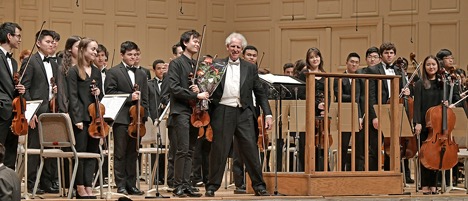Jackiw and BPYO Cure Warhorseitis

Three brisk repeated E naturals played in octaves in the brass and bassoons begin the Overture to Verdi’s La Forza del Destino; it continues with several short slow sections from the opera, before concluding in an extended brilliant section. If the Boston Philharmonic Youth Symphony performance lacked something of the opera’s dramatic display, it nevertheless made for a brilliant start to the season under Benjamin Zander.
Stefan Jackiw’s appearance in Mendelssohn’s Violin Concerto with Zander and the BPYO at Symphony Hall Sunday came almost exactly 20 years after his having done it with Zander and the London Philharmonic. In the intervening years Jackiw has been no stranger to his native Boston, having appeared in Rockport, Roxbury Latin, for the Gardner, for Boston Conservatory, for the Celebrity Series, with the Boston Symphony, and in a concerto with Zander and the BPO in 2012. He made his professional debut with the Boston Pops at the age of 12.
Jackiw’s immersion in historically informed performance style (yes this goes on in Mendelssohn) enlivened the warhorse concerto with much unexpected variety and interest. Instead of long lush melodic lines from the violin we heard shorter phrases given out with little vibrato and tapering off at the ends, their individual characters emphasized, and rhythmic motifs conveyed as gestures and not necessarily precisely in rhythm. Jackiw somehow made this approach sound utterly natural and un-studied.
The solo violin begins with essentially no orchestral introduction, typically characterizing the eight-bar theme with one sustained style throughout. But it subdivides into shorter phrases which Jackiw characterized differently, some more rhythmic and some more melodic. He took the same refreshing approach to Mendelssohn’s famous cadenza.
Zander and Jackiw agreed to interpret the Andante movement as a simple light song with two pulses per measure. Instead of the expected sustained violin tone filling the space between each 8th of the 6/8 time signature, we heard a floating pulse whose speed matched the harmonic changes of the music. It made perfect sense.
The virtuosic Allegro ma non troppo-Allegro molto vivace challenges the conductor and orchestra to stay with the soloist rhythmically, and they generally succeeded. Zander wisely emphasized steadiness of rhythm while staying close to Jackiw’s tempo instead of trying to be exactly with him at all times, which can unsettle all involved. He used the full string section, which also makes it harder to stay with the soloist, but gives all the string players a valuable and enjoyable experience. Overall, Zander led with appropriately varied lightness.
The exuberant response led to an encore, the Largo from Bach’s Sonata No. 3 in C Major for solo violin. Employing no expressive vibrato, Jackiw instead opted for lots of color changes from precise bow control; he made total emotional and musical sense of the notes, phrases, and larger architecture.
Before embarking with us in Mahler Symphony No. 1 in D Major, BZ shared his enthusiasm for its amazing range of sounds and emotions.
“The orchestra responded like true believers to Zander’s vigorous exhortations, from the French horn section rips in the first movement, to the several tempo changes in the second movement waltz, to the tautly controlled canon on the nursery rhyme Frere Jacques (in the minor tonality) third movement, to the wild and crazy final movement with many different sections, tempi, and transitions. “
 Crawford Best - The Boston Musical Intelligencer
Crawford Best - The Boston Musical Intelligencer